Levetiracetam
These highlights do not include all the information needed to use LEVETIRACETAM TABLETS safely and effectively. See full prescribing information for LEVETIRACETAM TABLETS. LEVETIRACETAM tablets, for oral use Initial U.S. Approval: 1999
3884cb76-822b-400d-9b24-49c286c9b6f7
HUMAN PRESCRIPTION DRUG LABEL
Mar 27, 2024
NorthStar RxLLC
DUNS: 830546433
Products 4
Detailed information about drug products covered under this FDA approval, including NDC codes, dosage forms, ingredients, and administration routes.
Levetiracetam
Product Details
FDA regulatory identification and product classification information
FDA Identifiers
Product Classification
Product Specifications
INGREDIENTS (10)
Levetiracetam
Product Details
FDA regulatory identification and product classification information
FDA Identifiers
Product Classification
Product Specifications
INGREDIENTS (12)
Levetiracetam
Product Details
FDA regulatory identification and product classification information
FDA Identifiers
Product Classification
Product Specifications
INGREDIENTS (11)
Levetiracetam
Product Details
FDA regulatory identification and product classification information
FDA Identifiers
Product Classification
Product Specifications
INGREDIENTS (11)
Drug Labeling Information
PACKAGE LABEL.PRINCIPAL DISPLAY PANEL
PACKAGE LABEL.PRINCIPAL DISPLAY PANEL
Hetero Label:
Levetiracetam Tablets, USP - 250 mg - 500s count container
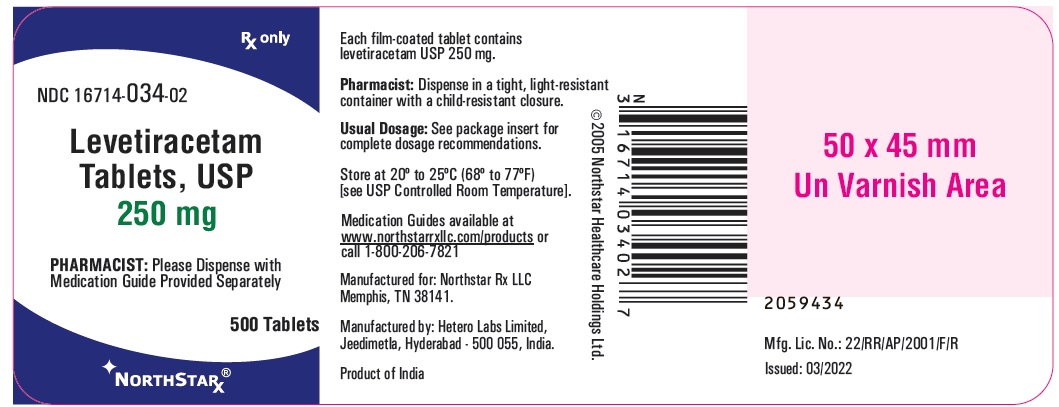
Levetiracetam Tablets, USP - 500 mg - 500s count container
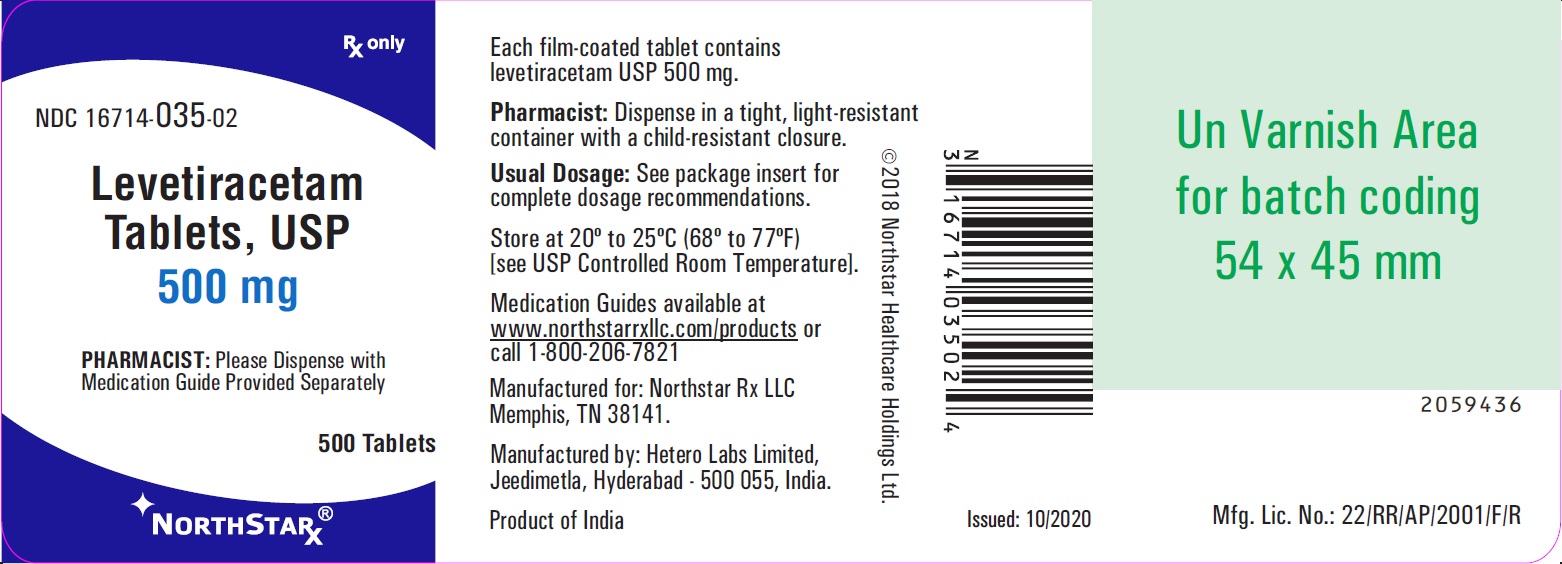
Levetiracetam Tablets, USP - 750 mg - 500s count container
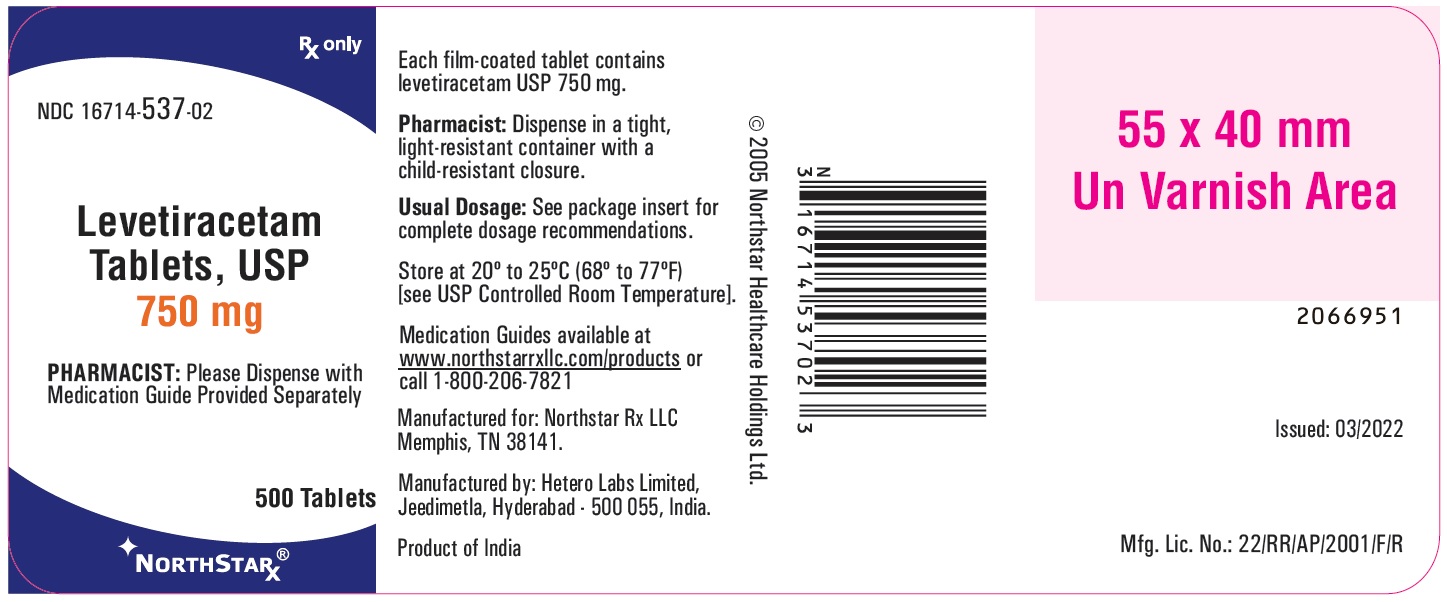
Levetiracetam Tablets, USP - 1000 mg - 60s count container
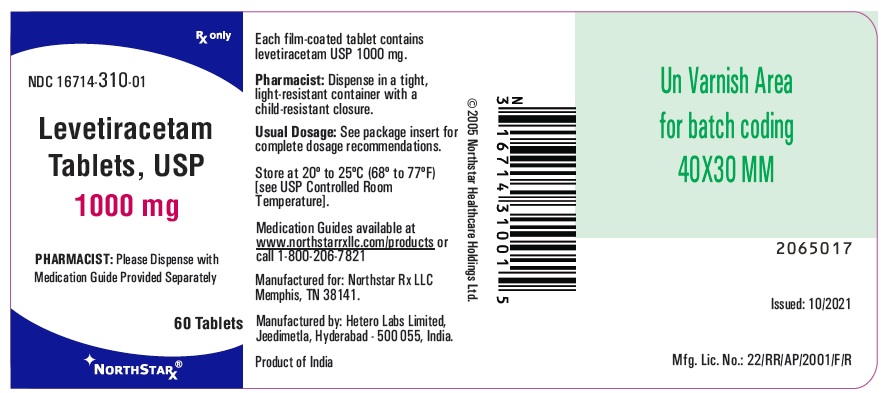
Annora Label:
Levetiracetam Tablets, USP - 250 mg - 120s count container
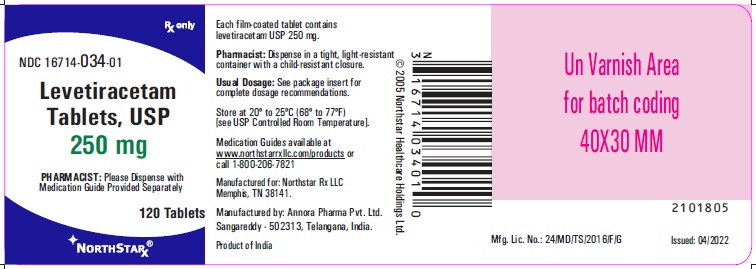
Levetiracetam Tablets, USP - 500 mg - 120s count container
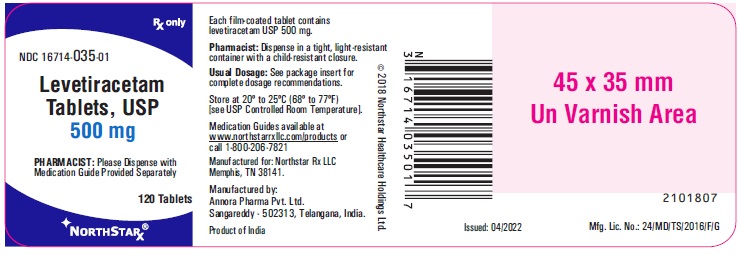
Levetiracetam Tablets, USP - 750 mg - 120s count container
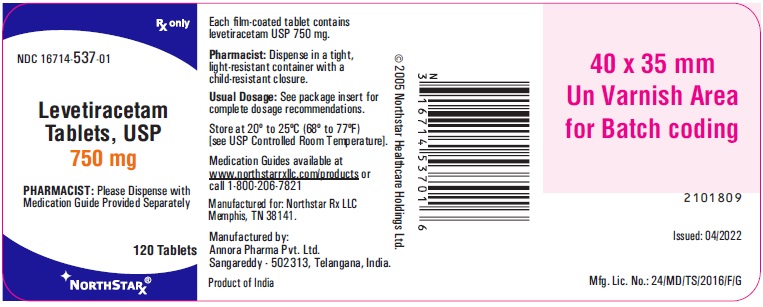
Levetiracetam Tablets, USP - 1000 mg - 60s count container
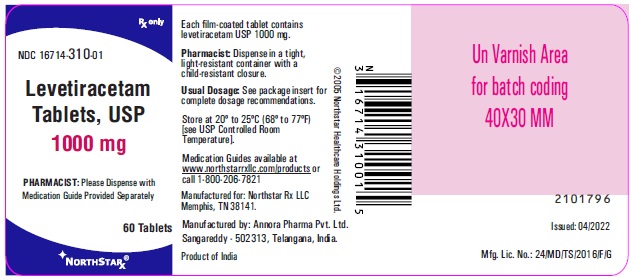
INDICATIONS & USAGE SECTION
1 INDICATIONS AND USAGE
1.1 Partial-Onset Seizures
Levetiracetam tablets are indicated for the treatment of partial-onset seizures in patients 1 month of age and older.
1.2 Myoclonic Seizures in Patients with Juvenile Myoclonic Epilepsy
Levetiracetam tablets are indicated as adjunctive therapy for the treatment of myoclonic seizures in patients 12 years of age and older with juvenile myoclonic epilepsy.
1.3 Primary Generalized Tonic-Clonic Seizures
Levetiracetam tablets are indicated as adjunctive therapy for the treatment of primary generalized tonic-clonic seizures in patients 6 years of age and older with idiopathic generalized epilepsy.
Levetiracetam tablets are indicated for the treatment of partial-onset
seizures in patients 1 month of age and older ( 1.1)
Levetiracetam tablets are indicated for adjunctive therapy for the treatment
of:
• Myoclonic seizures in patients 12 years of age and older with juvenile
myoclonic epilepsy ( 1.2)
• Primary generalized tonic-clonic seizures in patients 6 years of age and
older with idiopathic generalized epilepsy ( 1.3)
CONTRAINDICATIONS SECTION
4 CONTRAINDICATIONS
Levetiracetam tablets are contraindicated in patients with a hypersensitivity to levetiracetam. Reactions have included anaphylaxis and angioedema [see Warnings and Precautions ( 5.4)] .
Known hypersensitivity to levetiracetam; angioedema and anaphylaxis have occurred ( 4, 5.4)
WARNINGS AND PRECAUTIONS SECTION
5 WARNINGS AND PRECAUTIONS
5.1 Behavioral Abnormalities and Psychotic Symptoms
Levetiracetam may cause behavioral abnormalities and psychotic symptoms.
Patients treated with levetiracetam should be monitored for psychiatric signs
and symptoms.
Behavioral abnormalities
In clinical studies, 13% of adult levetiracetam-treated patients and 38% of
pediatric levetiracetam-treated patients (4 to 16 years of age) compared to 6%
and 19% of adult and pediatric placebo-treated patients, experienced non-
psychotic behavioral symptoms (reported as aggression, agitation, anger,
anxiety, apathy, depersonalization, depression, emotional lability, hostility,
hyperkinesias, irritability, nervousness, neurosis, and personality disorder).
A randomized double-blind, placebo-controlled study was performed to assess
the neurocognitive and behavioral effects of levetiracetam as adjunctive
therapy in pediatric patients (4 to 16 years of age). The results from an
exploratory analysis indicated a worsening in levetiracetam-treated patients
on aggressive behavior (one of eight behavior dimensions) as measured in a
standardized and systematic way using a validated instrument, the Achenbach
Child Behavior Checklist (CBCL/6 to 18).
In clinical studies in pediatric patients 1 month to < 4 years of age,
irritability was reported in 12% of the levetiracetam-treated patients
compared to 0% of placebo-treated patients.
In clinical studies, 1.7% of adult levetiracetam-treated patients discontinued
treatment due to behavioral adverse reactions, compared to 0.2% of placebo-
treated patients. The treatment dose was reduced in 0.8% of adult
levetiracetam-treated patients and in 0.5% of placebo-treated patients.
Overall, 11% of levetiracetam-treated pediatric patients experienced
behavioral symptoms associated with discontinuation or dose reduction,
compared to 6% of placebo-treated patients.
Psychotic symptoms
In clinical studies, 1% of levetiracetam-treated adult patients, 2% of
levetiracetam-treated pediatric patients 4 to 16 years of age, and 17% of
levetiracetam-treated pediatric patients 1 month to <4 years of age
experienced psychotic symptoms, compared to 0.2%, 2%, and 5% in the
corresponding age groups treated with placebo. In a controlled study that
assessed the neurocognitive and behavioral effects of levetiracetam in
pediatric patients 4 to 16 years of age, 1.6% of levetiracetam-treated
patients experienced paranoia, compared to 0% of placebo-treated patients. In
the same study, 3.1% of levetiracetam-treated patients experienced confusional
state, compared to 0% of placebo-treated patients [see Use in Specific Populations ( 8.4) ].
In clinical studies, two (0.3%) levetiracetam-treated adult patients were
hospitalized and their treatment was discontinued due to psychosis. Both
events, reported as psychosis, developed within the first week of treatment
and resolved within 1 to 2 weeks following treatment discontinuation. There
was no difference between drug and placebo-treated patients in the incidence
of the pediatric patients who discontinued treatment due to psychotic and non-
psychotic adverse reactions.
5.2 Suicidal Behavior and Ideation
Antiepileptic drugs (AEDs), including levetiracetam, increase the risk of
suicidal thoughts or behavior in patients taking these drugs for any
indication. Patients treated with any AED for any indication should be
monitored for the emergence or worsening of depression, suicidal thoughts or
behavior, and/or any unusual changes in mood or behavior.
Pooled analyses of 199 placebo-controlled clinical trials (mono- and
adjunctive therapy) of 11 different AEDs showed that patients randomized to
one of the AEDs had approximately twice the risk (adjusted Relative Risk 1.8,
95% CI:1.2, 2.7) of suicidal thinking or behavior compared to patients
randomized to placebo. In these trials, which had a median treatment duration
of 12 weeks, the estimated incidence rate of suicidal behavior or ideation
among 27,863 AED-treated patients was 0.43%, compared to 0.24% among 16,029
placebo-treated patients, representing an increase of approximately one case
of suicidal thinking or behavior for every 530 patients treated. There were
four suicides in drug-treated patients in the trials and none in placebo-
treated patients, but the number is too small to allow any conclusion about
drug effect on suicide.
The increased risk of suicidal thoughts or behavior with AEDs was observed as
early as one week after starting drug treatment with AEDs and persisted for
the duration of treatment assessed. Because most trials included in the
analysis did not extend beyond 24 weeks, the risk of suicidal thoughts or
behavior beyond 24 weeks could not be assessed.
The risk of suicidal thoughts or behavior was generally consistent among drugs
in the data analyzed. The finding of increased risk with AEDs of varying
mechanisms of action and across a range of indications suggests that the risk
applies to all AEDs used for any indication. The risk did not vary
substantially by age (5 to 100 years) in the clinical trials analyzed. Table 2
shows absolute and relative risk by indication for all evaluated AEDs
Table 2: Risk by Indication for Antiepileptic Drugs in the Pooled Analysis
|
Indication |
Placebo Patients with Events Per 1000 |
Drug Patients with Events Per 1000 |
Relative Risk: Incidence of Events in Drug Patients/Incidencein Placebo Patients |
Risk Difference: Additional Drug Patients with Events Per 1000 Patients |
|
Epilepsy |
1.0 |
3.4 |
3.5 |
2.4 |
|
Psychiatric |
5.7 |
8.5 |
1.5 |
2.9 |
|
Other |
1.0 |
1.8 |
1.9 |
0.9 |
|
Total |
2.4 |
4.3 |
1.8 |
1.9 |
The relative risk for suicidal thoughts or behavior was higher in clinical trials for epilepsy than in clinical trials for psychiatric or other conditions, but the absolute risk differences were similar for the epilepsy and psychiatric indications.
Anyone considering prescribing levetiracetam or any other AED must balance the risk of suicidal thoughts or behaviors with the risk of untreated illness. Epilepsy and many other illnesses for which AEDs are prescribed are themselves associated with morbidity and mortality and an increased risk of suicidal thoughts and behavior. Should suicidal thoughts and behavior emerge during treatment, the prescriber needs to consider whether the emergence of these symptoms in any given patient may be related to the illness being treated.
5.3 Somnolence and Fatigue
Levetiracetam may cause somnolence and fatigue. Patients should be monitored for these signs and symptoms and advised not to drive or operate machinery until they have gained sufficient experience on levetiracetam to gauge whether it adversely affects their ability to drive or operate machinery.
Somnolence
In controlled trials of adult patients with epilepsy experiencing partial-
onset seizures, 15% of levetiracetam-treated patients reported somnolence,
compared to 8% of placebo-treated patients. There was no clear dose response
up to 3000 mg/day. In a study where there was no titration, about 45% of
patients receiving 4000 mg/day reported somnolence. The somnolence was
considered serious in 0.3% of levetiracetam-treated patients, compared to 0%
in the placebo group. About 3% of levetiracetam-treated patients discontinued
treatment due to somnolence, compared to 0.7% of placebo-treated patients. In
1.4% of levetiracetam-treated patients and 0.9% of placebo-treated patients,
the dose was reduced, while 0.3% of the levetiracetam-treated patients were
hospitalized due to somnolence.
Asthenia
In controlled clinical studies of adult patients with epilepsy experiencing
partial-onset seizures, 15% of levetiracetam-treated patients reported
asthenia, compared to 9% of placebo-treated patients. Treatment was
discontinued due to asthenia in 0.8% of levetiracetam-treated patients as
compared to 0.5% of placebo-treated patients. In 0.5% of levetiracetam-treated
patients and in 0.2% of placebo-treated patients, the dose was reduced due to
asthenia.
Somnolence and asthenia occurred most frequently within the first 4 weeks of treatment. In general, the incidences of somnolence and fatigue in the pediatric partial-onset seizure studies, and in pediatric and adult myoclonic and primary generalized tonic-clonic seizure studies were comparable to those of the adult partial-onset seizure studies.
5.4 Anaphylaxis and Angioedema
Levetiracetam can cause anaphylaxis or angioedema after the first dose or at any time during treatment. Signs and symptoms in cases reported in the postmarketing setting have included hypotension, hives, rash, respiratory distress, and swelling of the face, lip, mouth, eye, tongue, throat, and feet. In some reported cases, reactions were life-threatening and required emergency treatment. If a patient develops signs or symptoms of anaphylaxis or angioedema, levetiracetam should be discontinued and the patient should seek immediate medical attention. Levetiracetam should be discontinued permanently if a clear alternative etiology for the reaction cannot be established [see Contraindications ( 4)] .
5.5 Serious Dermatological Reactions
Serious dermatological reactions, including Stevens-Johnson syndrome (SJS) and toxic epidermal necrolysis (TEN), have been reported in both pediatric and adult patients treated with levetiracetam. The median time of onset is reported to be 14 to 17 days, but cases have been reported at least four months after initiation of treatment. Recurrence of the serious skin reactions following rechallenge with levetiracetam has also been reported. Levetiracetam should be discontinued at the first sign of a rash, unless the rash is clearly not drug-related. If signs or symptoms suggest SJS/TEN, use of this drug should not be resumed and alternative therapy should be considered.
5.6 Coordination Difficulties
Levetiracetam may cause coordination difficulties.
In controlled clinical studies in adult patients with partial-onset seizure
studies, 3.4% of adult levetiracetam-treated patients experienced coordination
difficulties, (reported as either ataxia, abnormal gait, or incoordination)
compared to 1.6% of placebo-treated patients. A total of 0.4% of patients in
controlled clinical studies discontinued levetiracetam treatment due to
ataxia, compared to 0% of placebo-treated patients. In 0.7% of levetiracetam-
treated patients and in 0.2% of placebo-treated patients, the dose was reduced
due to coordination difficulties, while one of the levetiracetam-treated
patients was hospitalized due to worsening of pre-existing ataxia. These
events occurred most frequently within the first 4 weeks of treatment.
Patients should be monitored for these signs and symptoms and advised not to
drive or operate machinery until they have gained sufficient experience on
levetiracetam to gauge whether it could adversely affect their ability to
drive or operate machinery.
5.7 Withdrawal Seizures
As with most antiepileptic drugs, levetiracetam should generally be withdrawn gradually because of the risk of increased seizure frequency and status epilepticus. If withdrawal is needed because of a serious adverse reaction, rapid discontinuation can be considered.
5.8 Hematologic Abnormalities
Levetiracetam can cause hematologic abnormalities. Hematologic abnormalities occurred in clinical trials and included decreases in white blood cell (WBC), neutrophil, and red blood cell (RBC) counts; decreases in hemoglobin and hematocrit; and increases in eosinophil counts. Cases of agranulocytosis, pancytopenia, and thrombocytopenia have been reported in the postmarketing setting. A complete blood count is recommended in patients experiencing significant weakness, pyrexia, recurrent infections, or coagulation disorders.
Partial-Onset Seizures
Adults
Minor, but statistically significant, decreases compared to placebo in total
mean RBC count (0.03 x 10 6/mm 3), mean hemoglobin (0.09 g/dL), and mean
hematocrit (0.38%), were seen in levetiracetam-treated patients in controlled
trials.
A total of 3.2% of levetiracetam-treated and 1.8% of placebo-treated patients had at least one possibly significant (≤2.8 x 10 9/L) decreased WBC, and 2.4% of levetiracetam-treated and 1.4% of placebo-treated patients had at least one possibly significant (≤1.0 x 10 9/L) decreased neutrophil count. Of the levetiracetam-treated patients with a low neutrophil count, all but one rose towards or to baseline with continued treatment. No patient was discontinued secondary to low neutrophil counts.
Pediatric Patients 4 Years to < 16 Years
Statistically significant decreases in WBC and neutrophil counts were seen in
levetiracetam-treated patients as compared to placebo. The mean decreases from
baseline in the levetiracetam-treated group were -0.4 × 10 9/L and -0.3 × 10
9/L, respectively, whereas there were small increases in the placebo group.
Mean relative lymphocyte counts increased by 1.7% in levetiracetam-treated
patients, compared to a decrease of 4% in placebo patients (statistically
significant).
In the controlled trial, more levetiracetam-treated patients had a possibly
clinically significant abnormally low WBC value (3% of levetiracetam-treated
patients versus 0% of placebo-treated patients), however, there was no
apparent difference between treatment groups with respect to neutrophil count
(5% of levetiracetam-treated patients versus 4.2% of placebo-treated
patients). No patient was discontinued secondary to low WBC or neutrophil
counts.
In the controlled cognitive and neuropsychological safety study, 5 patients
(8.6%) in the levetiracetam-treated group and two patients (6.1%) in the
placebo-treated group had high eosinophil count values that were possibly
clinically significant (≥10% or ≥0.7 x 10 9/L).
5.9 Increase in Blood Pressure
In a randomized, placebo-controlled study in patients 1 month to <4 years of age, a significantly higher risk of increased diastolic blood pressure was observed in the levetiracetam-treated patients (17%), compared to the placebo- treated patients (2%). There was no overall difference in mean diastolic blood pressure between the treatment groups. This disparity between the levetiracetam and placebo treatment groups was not observed in the studies of older children or in adults.
Monitor patients 1 month to <4 years of age for increases in diastolic blood pressure.
5.10 Seizure Control During Pregnancy
Physiological changes may gradually decrease plasma levels of levetiracetam throughout pregnancy. This decrease is more pronounced during the third trimester. It is recommended that patients be monitored carefully during pregnancy. Close monitoring should continue through the postpartum period especially if the dose was changed during pregnancy.
• Behavioral abnormalities including psychotic symptoms, suicidal ideation,
irritability, and aggressive behavior have been observed; monitor patients for
psychiatric signs and symptoms ( 5.1)
• Suicidal Behavior and Ideation: Monitor patients for new or worsening
depression, suicidal thoughts/behavior, and/or unusual changes in mood or
behavior ( 5.2)
• Monitor for somnolence and fatigue and advise patients not to drive or
operate machinery until they have gained sufficient experience on
levetiracetam ( 5.3)
• Serious Dermatological Reactions: Discontinue levetiracetam at the first
sign of rash unless clearly not drug related. ( 5.5)
• Coordination Difficulties: Monitor for ataxia, abnormal gait, and
incoordination. Advise patients to not drive or operate machinery until they
have gained experience on levetiracetam. ( 5.6)
• Withdrawal Seizures: Levetiracetam must be gradually withdrawn ( 5.7)
ADVERSE REACTIONS SECTION
6 ADVERSE REACTIONS
The following adverse reactions are discussed in more details in other
sections of labeling:
• Behavior Abnormalities and Psychotic Symptoms [see Warnings and Precautions ( 5.1)]
• Suicidal Behavior and Ideation [see Warnings and Precautions ( 5.2)]
• Somnolence and Fatigue [see Warnings and Precautions ( 5.3)]
• Anaphylaxis and Angioedema [see Warnings and Precautions ( 5.4)]
• Serious Dermatological Reactions [see Warnings and Precautions ( 5.5)]
• Coordination Difficulties [see Warnings and Precautions ( 5.6)]
• Hematologic Abnormalities [see Warnings and Precautions ( 5.8)]
• Increase in Blood Pressure [see Warnings and Precautions ( 5.9)]
6.1 Clinical Trials Experience
Because clinical trials are conducted under widely varying conditions, adverse
reaction rates observed in the clinical trials of a drug cannot be directly
compared to rates in the clinical trials of another drug and may not reflect
the rates observed in practice.
Partial-Onset Seizures
Adults
In controlled clinical studies in adults with partial-onset seizures [see Clinical Studies ( 14.1)] , the most common adverse reactions in patients
receiving levetiracetam in combination with other AEDs, for events with rates
greater than placebo, were somnolence, asthenia, infection, and dizziness. Of
the most common adverse reactions in adults experiencing partial-onset
seizures, asthenia, somnolence, and dizziness occurred predominantly during
the first 4 weeks of treatment with levetiracetam.
Table 3 lists adverse reactions that occurred in at least 1% of adult epilepsy
patients receiving levetiracetam in placebo-controlled studies and were
numerically more common than in patients treated with placebo. In these
studies, either levetiracetam or placebo was added to concurrent AED therapy.
Table 3: Adverse Reactions in Pooled Placebo-Controlled, Adjunctive Studies
in Adults Experiencing Partial-Onset Seizures
|
Levetiracetam******(N=769)** |
Placebo******(N=439)** | |
|
Asthenia |
15 |
9 |
|
Somnolence |
15 |
8 |
|
Headache |
14 |
13 |
|
Infection |
13 |
8 |
|
Dizziness |
9 |
4 |
|
Pain |
7 |
6 |
|
Pharyngitis |
6 |
4 |
|
Depression |
4 |
2 |
|
Nervousness |
4 |
2 |
|
Rhinitis |
4 |
3 |
|
Anorexia |
3 |
2 |
|
Ataxia |
3 |
1 |
|
Vertigo |
3 |
1 |
|
Amnesia |
2 |
1 |
|
Anxiety |
2 |
1 |
|
Cough Increased |
2 |
1 |
|
Diplopia |
2 |
1 |
|
Emotional Lability |
2 |
0 |
|
Hostility |
2 |
1 |
|
Paresthesia |
2 |
1 |
|
Sinusitis |
2 |
1 |
In controlled adult clinical studies, 15% of patients receiving levetiracetam
and 12% receiving placebo either discontinued or had a dose reduction as a
result of an adverse reaction. Table 4 lists the most common (>1%) adverse
reactions that resulted in discontinuation or dose reduction and that occurred
more frequently in levetiracetam-treated patients than in placebo-treated
patients.
Table 4: Adverse Reactions that Resulted in Discontinuation or Dose
Reduction in Placebo-Controlled Studies in Adult Patients Experiencing
Partial-Onset Seizures
|
Adverse****Reaction |
Levetiracetam**** |
Placebo**** |
|
Somnolence |
4 |
2 |
|
Dizziness |
1 |
0 |
Pediatric Patients 4 Years to <16 Years
The adverse reaction data presented below was obtained from a pooled analysis
of two controlled pediatric clinical studies in pediatric patients 4 to 16
years of age with partial-onset seizures. The most common adverse reactions in
pediatric patients receiving levetiracetam in combination with other AEDs, for
events with rates greater than placebo, were fatigue, aggression, nasal
congestion, decreased appetite, and irritability.
Table 5 lists adverse reactions from the pooled pediatric controlled studies
(4 to 16 years of age) that occurred in at least 2% of pediatric
levetiracetam-treated patients and were numerically more common than in
pediatric patients treated with placebo. In these studies, either
levetiracetam or placebo was added to concurrent AED therapy.
**Table 5: Adverse Reactions in Pooled Placebo-Controlled, Adjunctive Studies in Pediatric Patients Ages 4 to 16 Years Experiencing Partial-Onset Seizures **
|
Levetiracetam |
Placebo**** | |
|
Headache |
19 |
15 |
|
Nasopharyngitis |
15 |
12 |
|
Vomiting |
15 |
12 |
|
Somnolence |
13 |
9 |
|
Fatigue |
11 |
5 |
|
Aggression |
10 |
5 |
|
Cough |
9 |
5 |
|
Nasal Congestion |
9 |
2 |
|
Upper Abdominal Pain |
9 |
8 |
|
Decreased Appetite |
8 |
2 |
|
Abnormal Behavior |
7 |
4 |
|
Dizziness |
7 |
5 |
|
Irritability |
7 |
1 |
|
Pharyngolaryngeal Pain |
7 |
4 |
|
Diarrhea |
6 |
2 |
|
Lethargy |
6 |
5 |
|
Insomnia |
5 |
3 |
|
Agitation |
4 |
1 |
|
Anorexia |
4 |
3 |
|
Head Injury |
4 |
0 |
|
Altered Mood |
3 |
1 |
|
Constipation |
3 |
1 |
|
Contusion |
3 |
1 |
|
Depression |
3 |
1 |
|
Fall |
3 |
2 |
|
Influenza |
3 |
1 |
|
Affect Lability |
2 |
1 |
|
Anxiety |
2 |
1 |
|
Arthralgia |
2 |
0 |
|
Confusional State |
2 |
0 |
|
Conjunctivitis |
2 |
0 |
|
Ear Pain |
2 |
1 |
|
Gastroenteritis |
2 |
0 |
|
Joint Sprain |
2 |
1 |
|
Mood Swings |
2 |
1 |
|
Neck Pain |
2 |
1 |
|
Rhinitis |
2 |
0 |
|
Sedation |
2 |
1 |
In the controlled pooled pediatric clinical studies in patients 4 to 16 years of age, 7% of patients receiving levetiracetam and 9% receiving placebo discontinued as a result of an adverse reaction.
Pediatric Patients 1 Month to < 4 Years
In the 7-day, controlled pediatric clinical study in children 1 month to less
than 4 years of age with partial-onset seizures, the most common adverse
reactions in patients receiving levetiracetam in combination with other AEDs,
for events with rates greater than placebo, were somnolence and irritability.
Because of the shorter exposure period, incidences of adverse reactions are
expected to be lower than in other pediatric studies in older patients.
Therefore, other controlled pediatric data, presented above, should also be
considered to apply to this age group.
Table 6 lists adverse reactions that occurred in at least 5% of pediatric epilepsy patients (ages 1 month to < 4 years) treated with levetiracetam in the placebo-controlled study and were numerically more common than in patients treated with placebo. In this study, either levetiracetam or placebo was added to concurrent AED therapy.
Table 6: Adverse Reactions in a Placebo-Controlled, Adjunctive Study in Pediatric Patients Ages 1 Month to <4 Years Experiencing Partial-Onset Seizures
|
Levetiracetam |
Placebo | |
|
Somnolence |
13 |
2 |
|
Irritability |
12 |
0 |
In the 7-day controlled pediatric clinical study in patients 1 month to < 4 years of age, 3% of patients receiving levetiracetam and 2% receiving placebo either discontinued or had a dose reduction as a result of an adverse reaction. There was no adverse reaction that resulted in discontinuation for more than one patient.
Myoclonic Seizures
Although the pattern of adverse reactions in this study seems somewhat
different from that seen in patients with partial-onset seizures, this is
likely due to the much smaller number of patients in this study compared to
partial seizure studies. The adverse reaction pattern for patients with JME is
expected to be essentially the same as for patients with partial seizures.
In the controlled clinical study in patients 12 years of age and older with
myoclonic seizures [see Clinical Studies ( 14.2)] , the most common adverse
reactions in patients receiving levetiracetam in combination with other AEDs,
for events with rates greater than placebo, were somnolence, neck pain, and
pharyngitis.
Table 7 lists adverse reactions that occurred in at least 5% of juvenile
myoclonic epilepsy patients experiencing myoclonic seizures treated with
levetiracetam and were numerically more common than in patients treated with
placebo. In this study, either levetiracetam or placebo was added to
concurrent AED therapy.
Table 7: Adverse Reactions in a Placebo-Controlled, Adjunctive Study in
Patients 12 Years of Age and Older with Myoclonic Seizures
|
Levetiracetam**** |
Placebo**** | |
|
Somnolence |
12 |
2 |
|
Neck pain |
8 |
2 |
|
Pharyngitis |
7 |
0 |
|
Depression |
5 |
2 |
|
Influenza |
5 |
2 |
|
Vertigo |
5 |
3 |
In the placebo-controlled study, 8% of patients receiving levetiracetam and 2%
receiving placebo either discontinued or had a dose reduction as a result of
an adverse reaction. The adverse reactions that led to discontinuation or dose
reduction and that occurred more frequently in levetiracetam-treated patients
than in placebo-treated patients are presented in Table 8.
Table 8: Adverse Reactions that Resulted in Discontinuation or Dose
Reduction in a Placebo-Controlled Study in Patients with Juvenile Myoclonic
Epilepsy
|
Adverse****Reaction |
Levetiracetam |
Placebo**** |
|
Anxiety |
3 |
2 |
|
Depressed mood |
2 |
0 |
|
Depression |
2 |
0 |
|
Diplopia |
2 |
0 |
|
Hypersomnia |
2 |
0 |
|
Insomnia |
2 |
0 |
|
Irritability |
2 |
0 |
|
Nervousness |
2 |
0 |
|
Somnolence |
2 |
0 |
Primary Generalized Tonic-Clonic Seizures
Although the pattern of adverse reactions in this study seems somewhat
different from that seen in patients with partial-onset seizures, this is
likely due to the much smaller number of patients in this study compared to
partial seizure studies. The adverse reaction pattern for patients with
primary generalized tonic-clonic (PGTC) seizures is expected to be essentially
the same as for patients with partial seizures.
In the controlled clinical study that included patients 4 years of age and
older with PGTC seizures [see Clinical Studies ( 14.3)] , the most common
adverse reaction in patients receiving levetiracetam in combination with other
AEDs, for events with rates greater than placebo, was nasopharyngitis.
Table 9 lists adverse reactions that occurred in at least 5% of idiopathic
generalized epilepsy patients experiencing PGTC seizures treated with
levetiracetam and were numerically more common than in patients treated with
placebo. In this study, either levetiracetam or placebo was added to
concurrent AED therapy.
Table 9: Adverse Reactions in a Placebo-Controlled, Adjunctive Study in
Patients 4 Years of Age and Older with PGTC Seizures
|
Levetiracetam |
Placebo**** | |
|
Nasopharyngitis |
14 |
5 |
|
Fatigue |
10 |
8 |
|
Diarrhea |
8 |
7 |
|
Irritability |
6 |
2 |
|
Mood swings |
5 |
1 |
In the placebo-controlled study, 5% of patients receiving levetiracetam and 8% receiving placebo either discontinued or had a dose reduction during the treatment period as a result of an adverse reaction.
This study was too small to adequately characterize the adverse reactions that could be expected to result in discontinuation of treatment in this population. It is expected that the adverse reactions that would lead to discontinuation in this population would be similar to those resulting in discontinuation in other epilepsy trials (see tables 4 and 8).
In addition, the following adverse reactions were seen in other controlled adult studies of levetiracetam: balance disorder, disturbance in attention, eczema, memory impairment, myalgia, and blurred vision.
Comparison of Gender, Age and Race
The overall adverse reaction profile of levetiracetam was similar between females and males. There are insufficient data to support a statement regarding the distribution of adverse reactions by age and race.
6.2 Postmarketing Experience
The following adverse reactions have been identified during postapproval use
of levetiracetam. Because these reactions are reported voluntarily from a
population of uncertain size, it is not always possible to reliably estimate
their frequency or establish a causal relationship to drug exposure.
The following adverse reactions have been reported in patients receiving
marketed levetiracetam worldwide. The listing is alphabetized: abnormal liver
function test, acute kidney injury, anaphylaxis, angioedema, agranulocytosis,
choreoathetosis, drug reaction with eosinophilia and systemic symptoms
(DRESS), dyskinesia, erythema multiforme, hepatic failure, hepatitis,
hyponatremia, muscular weakness, obsessive-compulsive disorders (OCD),
pancreatitis, pancytopenia (with bone marrow suppression identified in some of
these cases), panic attack, thrombocytopenia, weight loss, and worsening of
seizures including in patients with SCN8A mutations. Alopecia has been
reported with levetiracetam use; recovery was observed in majority of cases
where levetiracetam was discontinued.
Most common adverse reactions (incidence ≥ 5% more than placebo) include:
• Adult patients: somnolence, asthenia, infection and dizziness ( 6.1)
• Pediatric patients: fatigue, aggression, nasal congestion, decreased
appetite, and irritability ( 6.1)
To report SUSPECTED ADVERSE REACTIONS, contact NorthStar Rx LLC at 1-800-206-7821 or FDA at 1-800-FDA-1088 or****www.fda.gov/medwatch.
DOSAGE FORMS & STRENGTHS SECTION
3 DOSAGE FORMS AND STRENGTHS
Levetiracetam tablets USP, 250 mg are blue colored, oblong shaped, scored,
film coated tablets debossed with ‘H’ on one side and ‘87’ on other side.
Levetiracetam tablets USP, 500 mg are yellow colored, oblong shaped, scored,
film coated tablets debossed with ‘H’ on one side and ‘88’ on other side.
Levetiracetam tablets USP, 750 mg are orange colored, oblong shaped, scored,
film coated tablets debossed with ‘H’ on one side and ‘90’ on other side.
Levetiracetam tablets USP, 1000 mg are white colored, oblong shaped, scored,
film coated tablets debossed with ‘H’ on one side and ‘91’ on other side.
• 250 mg, 500 mg, 750 mg, and 1000 mg film-coated, scored tablets ( 3)
USE IN SPECIFIC POPULATIONS SECTION
8 USE IN SPECIFIC POPULATIONS
8.1 Pregnancy
Pregnancy Exposure Registry
There is a pregnancy exposure registry that monitors pregnancy outcomes in
women exposed to antiepileptic drugs (AEDs), including levetiracetam, during
pregnancy. Encourage women who are taking levetiracetam during pregnancy to
enroll in the North American Antiepileptic Drug (NAAED) pregnancy registry by
calling 1-888-233-2334 or visiting http://www.aedpregnancyregistry.org/.
Risk Summary
Prolonged experience with levetiracetam in pregnant women has not identified a
drug-associated risk of major birth defects or miscarriage, based on published
literature, which includes data from pregnancy registries and reflects
experience over two decades [see Human Data].In animal studies, levetiracetam
produced developmental toxicity (increased embryofetal and offspring
mortality, increased incidences of fetal structural abnormalities, decreased
embryofetal and offspring growth, neurobehavioral alterations in offspring) at
doses similar to human therapeutic doses [see Animal Data].
In the U.S. general population, the estimated background risk of major birth
defects and miscarriage in clinically recognized pregnancies is 2 to 4% and 15
to 20%, respectively. The background risk of major birth defects and
miscarriage for the indicated population is unknown.
Clinical Considerations
Levetiracetam blood levels may decrease during pregnancy [see Warnings and Precautions ( 5.10)] .
Physiological changes during pregnancy may affect levetiracetam concentration.
Decrease in levetiracetam plasma concentrations has been observed during
pregnancy. This decrease is more pronounced during the third trimester. Dose
adjustments may be necessary to maintain clinical response.
Data
Human Data
While available studies cannot definitively establish the absence of risk,
data from the published literature and pregnancy registries have not
established an association with levetiracetam use during pregnancy and major
birth defects or miscarriage.
Animal Data
When levetiracetam (0, 400, 1200, or 3600 mg/kg/day) was administered orally
to pregnant rats during the period of organogenesis, reduced fetal weights and
increased incidence of fetal skeletal variations were observed at the highest
dose tested. There was no evidence of maternal toxicity. The no-effect dose
for adverse effects on embryofetal developmental in rats (1200 mg/kg/day) is
approximately 4 times the maximum recommended human dose (MRHD) of 3000 mg on
a body surface area (mg/m 2) basis.
Oral administration of levetiracetam (0, 200, 600, or 1800 mg/kg/day) to
pregnant rabbits during the period of organogenesis resulted in increased
embryofetal mortality and incidence of fetal skeletal variations at the mid
and high dose and decreased fetal weights and increased incidence of fetal
malformations at the high dose, which was associated with maternal toxicity.
The no-effect dose for adverse effects on embryofetal development in rabbits
(200 mg/kg/day) is approximately equivalent to the MRHD on a mg/m 2 basis.
Oral administration of levetiracetam (0, 70, 350, or 1800 mg/kg/day) to female
rats throughout pregnancy and lactation led to an increased incidence of fetal
skeletal variations, reduced fetal body weight, and decreased growth in
offspring at the mid and high doses and increased pup mortality and
neurobehavioral alterations in offspring at the highest dose tested. There was
no evidence of maternal toxicity. The no-effect dose for adverse effects on
pre- and postnatal development in rats (70 mg/kg/day) is less than the MRHD on
a mg/m 2basis.
Oral administration of levetiracetam to rats during the latter part of
gestation and throughout lactation produced no adverse developmental or
maternal effects at doses of up to 1800 mg/kg/day (6 times the MRHD on a mg/m
2basis).
8.2 Lactation
Risk Summary
Levetiracetam is excreted in human milk. There are no data on the effects of
levetiracetam on the breastfed infant, or the effects on milk production.
The developmental and health benefits of breastfeeding should be considered
along with the mother’s clinical need for levetiracetam and any potential
adverse effects on the breastfed infant from levetiracetam or from the
underlying maternal condition.
8.4 Pediatric Use
The safety and effectiveness of levetiracetam for the treatment of partial- onset seizures in patients 1 month to 16 years of age have been established [see Clinical Pharmacology (12.3) and Clinical Studies ( 14.1)] . The dosing recommendation in these pediatric patients varies according to age group and is weight-based [see Dosage and Administration ( 2.2)] .
The safety and effectiveness of levetiracetam as adjunctive therapy for the
treatment of myoclonic seizures in adolescents 12 years of age and older with
juvenile myoclonic epilepsy have been established [see Clinical Studies ( 14.2)] .
The safety and effectiveness of levetiracetam as adjunctive therapy for the
treatment of primary generalized tonic-clonic seizures in pediatric patients
6 years of age and older with idiopathic generalized epilepsy have been
established [see Clinical Studies ( 14.3)] .
Safety and effectiveness for the treatment of partial-onset seizures in
pediatric patients below the age of 1 month; adjunctive therapy for the
treatment of myoclonic seizures in pediatric patients below the age of 12
years; and adjunctive therapy for the treatment of primary generalized tonic-
clonic seizures in pediatric patients below the age of 6 years have not been
established.
A 3-month, randomized, double-blind, placebo-controlled study was performed to
assess the neurocognitive and behavioral effects of levetiracetam as
adjunctive therapy in 98 (levetiracetam N=64, placebo N=34) pediatric
patients, ages 4 to 16 years old, with partial seizures that were inadequately
controlled. The target dose was 60 mg/kg/day. Neurocognitive effects were
measured by the Leiter-R Attention and Memory (AM) Battery, which measures
various aspects of a child's memory and attention. Although no substantive
differences were observed between the placebo and drug treated groups in the
median change from baseline in this battery, the study was not adequate to
assess formal statistical non-inferiority of the drug and placebo. The
Achenbach Child Behavior Checklist (CBCL/6 to 18), a standardized validated
tool used to assess a child’s competencies and behavioral/emotional problems,
was also assessed in this study. An analysis of the CBCL/6 to 18 indicated on
average a worsening in levetiracetam-treated patients in aggressive behavior,
one of the eight syndrome scores [see Warnings and Precautions ( 5.1)] .
Juvenile Animal Toxicity Data
Studies of levetiracetam in juvenile rats (dosed on postnatal days 4 through
52) and dogs (dosed from postnatal weeks 3 through 7) at doses of up to 1800
mg/kg/day (approximately 7 and 24 times, respectively, the maximum recommended
pediatric dose of 60 mg/kg/day on a mg/m 2basis) did not demonstrate adverse
effects on postnatal development.
8.5 Geriatric Use
There were 347 subjects in clinical studies of levetiracetam that were 65 and
over. No overall differences in safety were observed between these subjects
and younger subjects. There were insufficient numbers of elderly subjects in
controlled trials of epilepsy to adequately assess the effectiveness of
levetiracetam in these patients.
Levetiracetam is known to be substantially excreted by the kidney, and the
risk of adverse reactions to this drug may be greater in patients with
impaired renal function. Because elderly patients are more likely to have
decreased renal function, care should be taken in dose selection, and it may
be useful to monitor renal function [see Clinical Pharmacology ( 12.3)] .
8.6 Renal Impairment
Clearance of levetiracetam is decreased in patients with renal impairment and is correlated with creatinine clearance [see Clinical Pharmacology ( 12.3)] . Dose adjustment is recommended for patients with impaired renal function and supplemental doses should be given to patients after dialysis [see Dosage and Administration ( 2.5)].
Pregnancy: Plasma levels of levetiracetam may be decreased and therefore need to be monitored closely during pregnancy. Based on animal data, may cause fetal harm ( 5.10, 8.1)
DESCRIPTION SECTION
11 DESCRIPTION
Levetiracetam is an antiepileptic drug available as 250 mg (blue), 500 mg (yellow), 750 mg (orange) and 1000 mg (white) tablets for oral administration.
The chemical name of levetiracetam, a single enantiomer, is
(-)-(S)-α-ethyl-2-oxo-1-pyrrolidine acetamide, its molecular formula is C 8H
14N 2O 2and its molecular weight is 170.21. Levetiracetam is chemically
unrelated to existing antiepileptic drugs (AEDs). It has the following
structural formula:

Levetiracetam USP is a white to off-white crystalline powder with a faint odor
and a bitter taste. It is very soluble in water (1040 mg/mL). It is freely
soluble in chloroform (653 mg/mL) and in methanol (536 mg/mL), soluble in
ethanol (165 mg/mL), sparingly soluble in acetonitrile (57 mg/mL) and
practically insoluble in n-hexane. (Solubility limits are expressed as mg/mL
solvent.)
Levetiracetam tablets, USP contain the labeled amount of levetiracetam USP. Inactive ingredients: corn starch, croscarmellose sodium, colloidal silicon dioxide, magnesium stearate, povidone, talc and additional agents listed below:
250 mg tablets: opadry II blue (FD&C blue #2/indigo carmine aluminum lake,
polyvinyl alcohol, polyethylene glycol 3350, titanium dioxide, talc)
500 mg tablets: opadry II yellow (iron oxide yellow, polyvinyl alcohol,
polyethylene glycol 3350, titanium dioxide, talc)
750 mg tablets: opadry II orange (FD&C yellow # 6/sunset yellow FCF aluminum lake, iron oxide red, polyvinyl alcohol, polyethylene glycol 3350, titanium dioxide, talc)
1000 mg tablets: opadry II white (polyvinyl alcohol, polyethylene glycol 3350, titanium dioxide, talc)
USP Dissolution test is 4.
CLINICAL PHARMACOLOGY SECTION
12 CLINICAL PHARMACOLOGY
12.1 Mechanism of Action
The precise mechanism(s) by which levetiracetam exerts its antiepileptic effect is unknown.
A saturable and stereoselective neuronal binding site in rat brain tissue has been described for levetiracetam. Experimental data indicate that this binding site is the synaptic vesicle protein SV2A, thought to be involved in the regulation of vesicle exocytosis. Although the molecular significance of levetiracetam binding to SV2A is not understood, levetiracetam and related analogs showed a rank order of affinity for SV2A which correlated with the potency of their antiseizure activity in audiogenic seizure-prone mice. These findings suggest that the interaction of levetiracetam with the SV2A protein may contribute to the antiepileptic mechanism of action of the drug.
12.2 Pharmacodynamics
Effects on QTc Interval
The effect of levetiracetam on QTc prolongation was evaluated in a randomized,
double-blind, positive-controlled (moxifloxacin 400 mg) and placebo-controlled
crossover study of levetiracetam (1000 mg or 5000 mg) in 52 healthy subjects.
The upper bound of the 90% confidence interval for the largest placebo-
adjusted, baseline-corrected QTc was below 10 milliseconds. Therefore, there
was no evidence of significant QTc prolongation in this study.
12.3 Pharmacokinetics
The pharmacokinetics of levetiracetam are similar when used as monotherapy or
as adjunctive therapy for the treatment of partial-onset seizures.
Absorption and Distribution
Absorption of levetiracetam is rapid, with peak plasma concentrations
occurring in about an hour following oral administration in fasted subjects.
The oral bioavailability of levetiracetam tablets is 100% and the tablets and
oral solution are bioequivalent in rate and extent of absorption. Food does
not affect the extent of absorption of levetiracetam but it decreases C maxby
20% and delays T maxby 1.5 hours. The pharmacokinetics of levetiracetam are
linear over the dose range of 500 to 5000 mg. Steady state is achieved after 2
days of multiple twice-daily dosing. Levetiracetam and its major metabolite
are less than 10% bound to plasma proteins; clinically significant
interactions with other drugs through competition for protein binding sites
are therefore unlikely.
Metabolism
Levetiracetam is not extensively metabolized in humans. The major metabolic
pathway is the enzymatic hydrolysis of the acetamide group, which produces the
carboxylic acid metabolite, ucb L057 (24% of dose) and is not dependent on any
liver cytochrome P450 isoenzymes. The major metabolite is inactive in animal
seizure models. Two minor metabolites were identified as the product of
hydroxylation of the 2-oxo-pyrrolidine ring (2% of dose) and opening of the
2-oxo-pyrrolidine ring in position 5 (1% of dose). There is no enantiomeric
interconversion of levetiracetam or its major metabolite.
Elimination
Levetiracetam plasma half-life in adults is 7±1 hour and is unaffected by
either dose or repeated administration. Levetiracetam is eliminated from the
systemic circulation by renal excretion as unchanged drug which represents 66%
of administered dose. The total body clearance is 0.96 mL/min/kg and the renal
clearance is 0.6 mL/min/kg. The mechanism of excretion is glomerular
filtration with subsequent partial tubular reabsorption. The metabolite ucb
L057 is excreted by glomerular filtration and active tubular secretion with a
renal clearance of 4 mL/min/kg. Levetiracetam elimination is correlated to
creatinine clearance. Levetiracetam clearance is reduced in patients with
renal impairment [see Use in Specific Populations ( 8.6) and Dosage and Administration ( 2.5)] .
Specific Populations
Elderly
Pharmacokinetics of levetiracetam were evaluated in 16 elderly subjects (age
61 to 88 years) with creatinine clearance ranging from 30 to 74 mL/min.
Following oral administration of twice-daily dosing for 10 days, total body
clearance decreased by 38% and the half-life was 2.5 hours longer in the
elderly compared to healthy adults. This is most likely due to the decrease in
renal function in these subjects.
Pediatric Patients
Pharmacokinetics of levetiracetam were evaluated in 24 pediatric patients (age
6 to 12 years) after single dose (20 mg/kg). The body weight adjusted apparent
clearance of levetiracetam was approximately 40% higher than in adults.
A repeat dose pharmacokinetic study was conducted in pediatric patients (age 4
to 12 years) at doses of 20 mg/kg/day, 40 mg/kg/day, and 60 mg/kg/day. The
evaluation of the pharmacokinetic profile of levetiracetam and its metabolite
(ucb L057) in 14 pediatric patients demonstrated rapid absorption of
levetiracetam at all doses with a T maxof about 1 hour and a t 1/2of 5 hours
across the three dosing levels. The pharmacokinetics of levetiracetam in
children was linear between 20 to 60 mg/kg/day. The potential interaction of
levetiracetam with other AEDs was also evaluated in these patients.
Levetiracetam had no significant effect on the plasma concentrations of
carbamazepine, valproic acid, topiramate or lamotrigine. However, there was
about a 22% increase of apparent clearance of levetiracetam when it was co-
administered with an enzyme-inducing AED (e.g. carbamazepine).
Following single dose administration (20 mg/kg) of a 10% oral solution to
children with epilepsy (1 month to < 4 years), levetiracetam was rapidly
absorbed and peak plasma concentrations were observed approximately 1 hour
after dosing. The pharmacokinetic results indicated that half-life was shorter
(5.3 h) than for adults (7.2 h) and apparent clearance was faster (1.5
mL/min/kg) than for adults (0.96 mL/min/kg).
Population pharmacokinetic analysis showed that body weight was significantly
correlated to the clearance of levetiracetam in pediatric patients; clearance
increased with an increase in body weight.
Pediatric Patients with Obesity
A population PK analysis of levetiracetam was conducted in 164 obese and non-
obese pediatric patients 2 to <18 years of age with median (range) weight 39.2
(11.3 to 134) kg to evaluate the potential impact of obesity on plasma
levetiracetam exposures. Obesity was defined as BMI ≥95th percentile for age
and sex based on CDC 2000 growth chart recommendations. Simulations were
conducted for obese and non-obese pediatric patients ages 4 to <16 years.
• When the recommended tablet dose is administered to pediatric patients
weighing < 40 kg, obese pediatric patients have 27% higher median C max,ssand
19% higher median C min,sscompared to non-obese patients.
• When the recommended tablet dose is administered to pediatric patients
weighing ≥ 40 kg, obese pediatric patients have 10 to 11% lower median C
max,ssand 2% lower median C min,sscompared to non-obese patients.
• When the recommended oral solution dose is administered to pediatric
patients across the full weight range, obese pediatric patients have 25%
higher median C max,ssand 41% higher median C min,sscompared to non-obese
pediatric patients.
However, differences in exposures between obese and non-obese pediatric
patients are not expected to be clinically meaningful because the recommended
dose titration at initiation of levetiracetam therapy would establish an
appropriate dose for each individual patient.
Pregnancy
Levetiracetam levels may decrease during pregnancy [see Warnings and Precautions ( 5.10) and Use in Specific Populations ( 8.1)] .
Gender
Levetiracetam C maxand AUC were 20% higher in women (N=11) compared to men
(N=12). However, clearances adjusted for body weight were comparable.
Race
Formal pharmacokinetic studies of the effects of race have not been conducted.
Cross-study comparisons involving Caucasians (N=12) and Asians (N=12),
however, show that pharmacokinetics of levetiracetam were comparable between
the two races. Because levetiracetam is primarily renally excreted and there
are no important racial differences in creatinine clearance, pharmacokinetic
differences due to race are not expected.
Renal Impairment
The disposition of levetiracetam was studied in adult subjects with varying
degrees of renal function. Total body clearance of levetiracetam is reduced in
patients with impaired renal function by 40% in the mild group (CLcr = 50 to
80 mL/min), 50% in the moderate group (CLcr = 30 to 50 mL/min) and 60% in the
severe renal impairment group (CLcr <30 mL/min). Clearance of levetiracetam is
correlated with creatinine clearance.
In anuric (end stage renal disease) patients, the total body clearance
decreased 70% compared to normal subjects (CLcr >80 mL/min). Approximately 50%
of the pool of levetiracetam in the body is removed during a standard 4-hour
hemodialysis procedure [see Dosage and Administration ( 2.5)] .
Hepatic Impairment
In subjects with mild (Child-Pugh A) to moderate (Child-Pugh B) hepatic
impairment, the pharmacokinetics of levetiracetam were unchanged. In patients
with severe hepatic impairment (Child-Pugh C), total body clearance was 50%
that of normal subjects, but decreased renal clearance accounted for most of
the decrease. No dose adjustment is needed for patients with hepatic
impairment.
Drug Interactions
In vitrodata on metabolic interactions indicate that levetiracetam is unlikely
to produce, or be subject to, pharmacokinetic interactions. Levetiracetam and
its major metabolite, at concentrations well above C maxlevels achieved within
the therapeutic dose range, are neither inhibitors of, nor high affinity
substrates for, human liver cytochrome P450 isoforms, epoxide hydrolase or
UDP-glucuronidation enzymes. In addition, levetiracetam does not affect the in
vitroglucuronidation of valproic acid.
Potential pharmacokinetic interactions of or with levetiracetam were assessed
in clinical pharmacokinetic studies (phenytoin, valproate, warfarin, digoxin,
oral contraceptive, probenecid) and through pharmacokinetic screening in the
placebo-controlled clinical studies in epilepsy patients.
Phenytoin
Levetiracetam (3000 mg daily) had no effect on the pharmacokinetic disposition
of phenytoin in patients with refractory epilepsy. Pharmacokinetics of
levetiracetam were also not affected by phenytoin.
Valproate
Levetiracetam (1500 mg twice daily) did not alter the pharmacokinetics of
valproate in healthy volunteers. Valproate 500 mg twice daily did not modify
the rate or extent of levetiracetam absorption or its plasma clearance or
urinary excretion. There also was no effect on exposure to and the excretion
of the primary metabolite, ucb L057.
Other Antiepileptic Drugs
Potential drug interactions between levetiracetam and other AEDs
(carbamazepine, gabapentin, lamotrigine, phenobarbital, phenytoin, primidone
and valproate) were also assessed by evaluating the serum concentrations of
levetiracetam and these AEDs during placebo-controlled clinical studies. These
data indicate that levetiracetam does not influence the plasma concentration
of other AEDs and that these AEDs do not influence the pharmacokinetics of
levetiracetam.
Effect of AEDs in Pediatric Patients
There was about a 22% increase of apparent total body clearance of
levetiracetam when it was co-administered with enzyme-inducing AEDs. Dose
adjustment is not recommended. Levetiracetam had no effect on plasma
concentrations of carbamazepine, valproate, topiramate, or lamotrigine.
Oral Contraceptives
Levetiracetam (500 mg twice daily) did not influence the pharmacokinetics of
an oral contraceptive containing 0.03 mg ethinyl estradiol and 0.15 mg
levonorgestrel, or of the luteinizing hormone and progesterone levels,
indicating that impairment of contraceptive efficacy is unlikely.
Coadministration of this oral contraceptive did not influence the
pharmacokinetics of levetiracetam.
Digoxin
Levetiracetam (1000 mg twice daily) did not influence the pharmacokinetics and
pharmacodynamics (ECG) of digoxin given as a 0.25 mg dose every day.
Coadministration of digoxin did not influence the pharmacokinetics of
levetiracetam.
Warfarin
Levetiracetam (1000 mg twice daily) did not influence the pharmacokinetics of
R and S warfarin. Prothrombin time was not affected by levetiracetam.
Coadministration of warfarin did not affect the pharmacokinetics of
levetiracetam.
Probenecid
Probenecid, a renal tubular secretion blocking agent, administered at a dose
of 500 mg four times a day, did not change the pharmacokinetics of
levetiracetam 1000 mg twice daily. C ssmaxof the metabolite, ucb L057, was
approximately doubled in the presence of probenecid while the fraction of drug
excreted unchanged in the urine remained the same. Renal clearance of ucb L057
in the presence of probenecid decreased 60%, probably related to competitive
inhibition of tubular secretion of ucb L057. The effect of levetiracetam on
probenecid was not studied.
SPL MEDGUIDE SECTION
MEDICATION GUIDE
|
Levetiracetam Tablets, USP |
|
Read this Medication Guide before you start taking levetiracetam tablets and each time you get a refill. There may be new information. This information does not take the place of talking to your healthcare provider about your medical condition or treatment. |
|
What is the most important information I should know about levetiracetam
tablets? |
|
What are levetiracetam tablets? • myoclonic seizures in people 12 years of age and older with juvenile
myoclonic epilepsy. Before taking your medicine, make sure you have received the correct medicine. Compare the name above with the name on your bottle and the appearance of your medicine with the description of levetiracetam tablets provided below. Tell your pharmacist immediately if you think you have been given the wrong medicine. |
|
Who should not take levetiracetam tablets? |
|
What should I tell my healthcare provider before starting levetiracetam
tablets? |
|
How should I take levetiracetam tablets? |
|
What are the possible side effects of levetiracetam tablets? Levetiracetam tablets can cause serious side effects including: |
|
How should I store levetiracetam tablets? |
|
General information about the safe and effective use of levetiracetam
tablets. |
|
What are the ingredients in levetiracetam tablets? Manufactured for: |
This Medication Guide has been approved by the U.S. Food and Drug Administration.
Revised: 11/2023
NONCLINICAL TOXICOLOGY SECTION
13 NONCLINICAL TOXICOLOGY
13.1 Carcinogenesis, Mutagenesis, Impairment of Fertility
Carcinogenesis
Rats were dosed with levetiracetam in the diet for 104 weeks at doses of 50,
300, and 1800 mg/kg/day. Plasma exposure (AUC) at the highest dose was
approximately 6 times that in humans at the maximum recommended daily human
dose (MRHD) of 3000 mg. There was no evidence of carcinogenicity. In mice,
oral administration of levetiracetam for 80 weeks (doses up to 960 mg/kg/day)
or 2 years (doses up to 4000 mg/kg/day, lowered to 3000 mg/kg/day after 45
weeks due to intolerability) was not associated with an increase in tumors.
The highest dose tested in mice for 2 years (3000 mg/kg/day) is approximately
5 times the MRHD on a body surface area (mg/m 2) basis.
Mutagenesis
Levetiracetam was negative in in vitro(Ames, chromosomal aberration in
mammalian cells) and in vivo(mouse micronucleus) assays. The major human
metabolite of levetiracetam (ucb L057) was negative in in vitro(Ames, mouse
lymphoma) assays.
Impairment of Fertility
No adverse effects on male or female fertility or reproductive performance
were observed in rats at oral doses up to 1800 mg/kg/day, which were
associated with plasma exposures (AUC) up to approximately 6 times that in
humans at the MRHD.
OVERDOSAGE SECTION
10 OVERDOSAGE
10.1 Signs, Symptoms and Laboratory Findings of Acute Overdosage in Humans
The highest known dose of levetiracetam received in the clinical development program was 6000 mg/day. Other than drowsiness, there were no adverse reactions in the few known cases of overdose in clinical trials. Cases of somnolence, agitation, aggression, depressed level of consciousness, respiratory depression and coma were observed with levetiracetam overdoses in postmarketing use.
10.2 Management of Overdose
There is no specific antidote for overdose with levetiracetam. If indicated, elimination of unabsorbed drug should be attempted by emesis or gastric lavage; usual precautions should be observed to maintain airway. General supportive care of the patient is indicated including monitoring of vital signs and observation of the patient’s clinical status. A Certified Poison Control Center should be contacted for up to date information on the management of overdose with levetiracetam.
10.3 Hemodialysis
Standard hemodialysis procedures result in significant clearance of levetiracetam (approximately 50% in 4 hours) and should be considered in cases of overdose. Although hemodialysis has not been performed in the few known cases of overdose, it may be indicated by the patient's clinical state or in patients with significant renal impairment.
CLINICAL STUDIES SECTION
14 CLINICAL STUDIES
14.1 Partial-Onset Seizures
Effectiveness in Partial-Onset Seizures in Adults
The effectiveness of levetiracetam for the treatment of partial-onset seizures
in adults was established in three multicenter, randomized, double-blind,
placebo-controlled clinical studies in patients who had refractory partial-
onset seizures with or without secondary generalization. The tablet
formulation was used in all these studies. In these studies, 904 patients were
randomized to placebo, 1000 mg, 2000 mg, or 3000 mg/day. Patients enrolled in
Study 1 or Study 2 had refractory partial-onset seizures for at least two
years and had taken two or more classical AEDs. Patients enrolled in Study 3
had refractory partial-onset seizures for at least 1 year and had taken one
classical AED. At the time of the study, patients were taking a stable dose
regimen of at least one and could take a maximum of two AEDs. During the
baseline period, patients had to have experienced at least two partial-onset
seizures during each 4-week period.
Study 1
Study 1 was a double-blind, placebo-controlled, parallel-group study conducted
at 41 sites in the United States comparing levetiracetam 1000 mg/day (N=97),
levetiracetam 3000 mg/day (N=101), and placebo (N=95) given in equally divided
doses twice daily. After a prospective baseline period of 12 weeks, patients
were randomized to one of the three treatment groups described above. The
18-week treatment period consisted of a 6-week titration period, followed by a
12-week fixed dose evaluation period, during which concomitant AED regimens
were held constant. The primary measure of effectiveness was a between group
comparison of the percent reduction in weekly partial seizure frequency
relative to placebo over the entire randomized treatment period (titration +
evaluation period). Secondary outcome variables included the responder rate
(incidence of patients with ≥50% reduction from baseline in partial onset
seizure frequency). The results of the analysis of Study 1 are displayed in
Table 10.
Table 10: Reduction in Mean Over Placebo in Weekly Frequency of Partial-
Onset Seizures in Study 1
|
Placebo(N=95) |
Levetiracetam |
Levetiracetam 3000 mg/day (N=101) | |
|
Percent reduction in partial seizure frequency over placebo |
– |
26.1%* |
30.1%* |
statistically significant versus placebo
The percentage of patients (y-axis) who achieved ≥50% reduction in weekly
seizure rates from baseline in partial-onset seizure frequency over the entire
randomized treatment period (titration + evaluation period) within the three
treatment groups (x-axis) is presented in Figure 1.***
** Figure 1: Responder Rate (≥50% Reduction from Baseline) in Study 1**
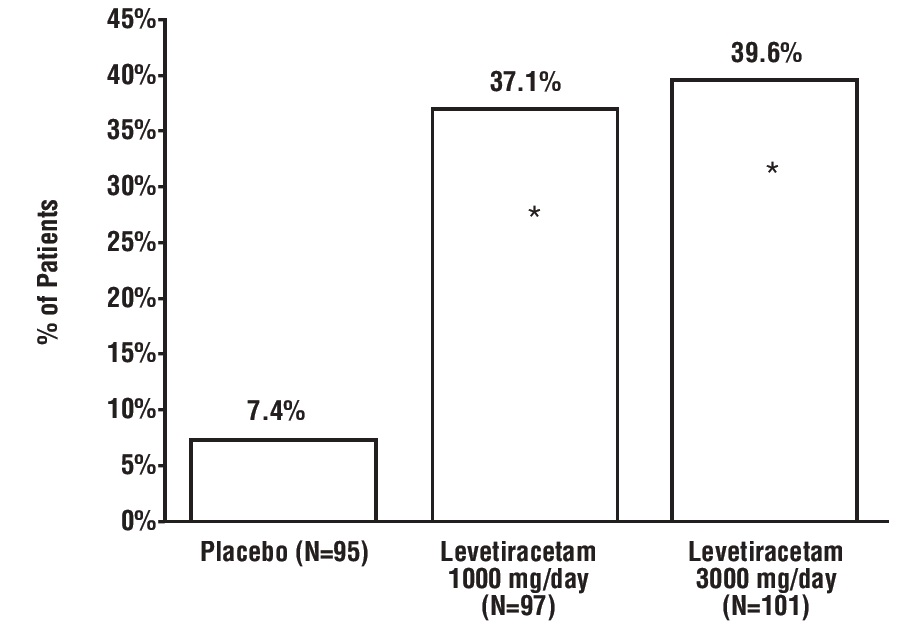
*statistically significant versus placebo
Study 2
Study 2 was a double-blind, placebo-controlled, crossover study conducted at
62 centers in Europe comparing levetiracetam 1000 mg/day (N=106),
levetiracetam 2000 mg/day (N=105), and placebo (N=111) given in equally
divided doses twice daily.
The first period of the study (Period A) was designed to be analyzed as a
parallel-group study. After a prospective baseline period of up to 12 weeks,
patients were randomized to one of the three treatment groups described above.
The 16-week treatment period consisted of the 4-week titration period followed
by a 12-week fixed dose evaluation period, during which concomitant AED
regimens were held constant. The primary measure of effectiveness was a
between group comparison of the percent reduction in weekly partial seizure
frequency relative to placebo over the entire randomized treatment period
(titration + evaluation period). Secondary outcome variables included the
responder rate (incidence of patients with ≥50% reduction from baseline in
partial-onset seizure frequency). The results of the analysis of Period A are
displayed in Table 11.
Table 11: Reduction in Mean Over Placebo in Weekly Frequency of Partial-
Onset Seizures in Study 2: Period A
|
Placebo (N=111) |
Levetiracetam 1000 mg/day (N=106) |
Levetiracetam 2000 mg/day (N=105) | |
|
Percent reduction in partial seizure frequency over placebo |
– |
17.1%* |
21.4%* |
statistically significant versus placebo
The percentage of patients (y-axis) who achieved ≥50% reduction in weekly
seizure rates from baseline in partial-onset seizure frequency over the entire
randomized treatment period (titration + evaluation period) within the three
treatment groups (x-axis) is presented in Figure 2.
**Figure 2: Responder Rate (*≥** 50% Reduction from Baseline) in Study
2: Period A**
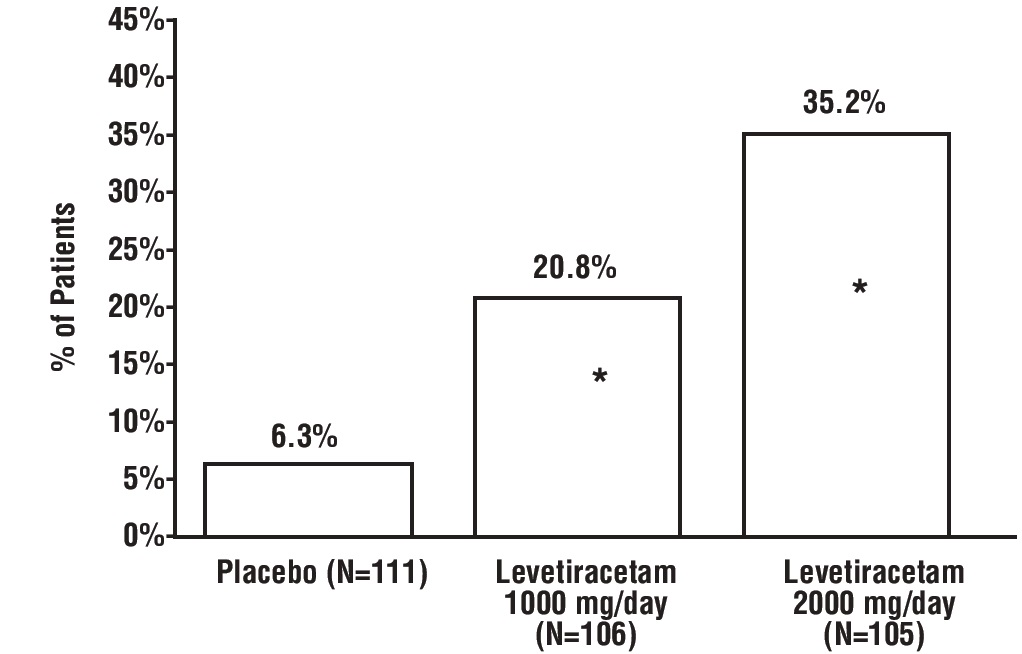
*statistically significant versus placebo
The comparison of levetiracetam 2000 mg/day to levetiracetam 1000 mg/day for
responder rate was statistically significant (P=0.02). Analysis of the trial
as a cross-over yielded similar results.
Study 3
Study 3 was a double-blind, placebo-controlled, parallel-group study conducted
at 47 centers in Europe comparing levetiracetam 3000 mg/day (N=180) and
placebo (N=104) in patients with refractory partial-onset seizures, with or
without secondary generalization, receiving only one concomitant AED. Study
drug was given in two divided doses. After a prospective baseline period of 12
weeks, patients were randomized to one of two treatment groups described
above. The 16-week treatment period consisted of a 4-week titration period,
followed by a 12-week fixed dose evaluation period, during which concomitant
AED doses were held constant. The primary measure of effectiveness was a
between group comparison of the percent reduction in weekly seizure frequency
relative to placebo over the entire randomized treatment period (titration +
evaluation period). Secondary outcome variables included the responder rate
(incidence of patients with ≥50% reduction from baseline in partial-onset
seizure frequency). Table 12 displays the results of the analysis of Study 3.
Table 12: Reduction in Mean Over Placebo in Weekly Frequency of Partial-
Onset Seizures in Study 3
|
Placebo (N=104) |
Levetiracetam | |
|
Percent reduction in partial seizure frequency over placebo |
– |
23.0%* |
statistically significant versus placebo
The percentage of patients (y-axis) who achieved ≥50% reduction in weekly
seizure rates from baseline in partial-onset seizure frequency over the entire
randomized treatment period (titration + evaluation period) within the two
treatment groups (x-axis) is presented in Figure 3.
**Figure 3: Responder Rate (*≥** 50% Reduction from Baseline) in Study 3
**
****
*****statistically significant versus placebo
Effectiveness in Partial-Onset Seizures in Pediatric Patients 4 to 16 Years of
Age
The effectiveness of levetiracetam for the treatment of partial-onset seizures
in pediatric patients was established in one multicenter, randomized double-
blind, placebo-controlled study (Study 4), conducted at 60 sites in North
America, in pediatric patients 4 to 16 years of age with partial seizures
uncontrolled by standard antiepileptic drugs (AEDs). Eligible patients on a
stable dose of 1 to 2 AEDs, who still experienced at least 4 partial-onset
seizures during the 4 weeks prior to screening, as well as at least 4 partial-
onset seizures in each of the two 4-week baseline periods, were randomized to
receive either levetiracetam or placebo. The enrolled population included 198
patients (levetiracetam N=101, placebo N=97) with refractory partial-onset
seizures, whether or not secondarily generalized. The study consisted of an
8-week baseline period and 4-week titration period followed by a 10-week
evaluation period. Dosing was initiated at a dose of 20 mg/kg/day in two
divided doses. During the treatment period, levetiracetam doses were adjusted
in 20 mg/kg/day increments, at 2-week intervals to the target dose of 60
mg/kg/day. The primary measure of effectiveness was a between group comparison
of the percent reduction in weekly partial seizure frequency relative to
placebo over the entire 14-week randomized treatment period (titration +
evaluation period). Secondary outcome variables included the responder rate
(incidence of patients with ≥50% reduction from baseline in partial-onset
seizure frequency per week). Table 13 displays the results of this study.
Table 13: Reduction in Mean Over Placebo in Weekly Frequency of Partial-
Onset Seizures in Study 4
|
Placebo |
Levetiracetam | |
|
(N=97) |
(N=101) | |
|
Percent reduction in partial seizure frequency over placebo |
- |
26.8%* |
*statistically significant versus placebo
The percentage of patients (y-axis) who achieved ≥ 50% reduction in weekly
seizure rates from baseline in partial-onset seizure frequency over the entire
randomized treatment period (titration + evaluation period) within the two
treatment groups (x-axis) is presented in Figure 4.
Figure 4: Responder Rate (≥ 50% Reduction from Baseline) in Study 4
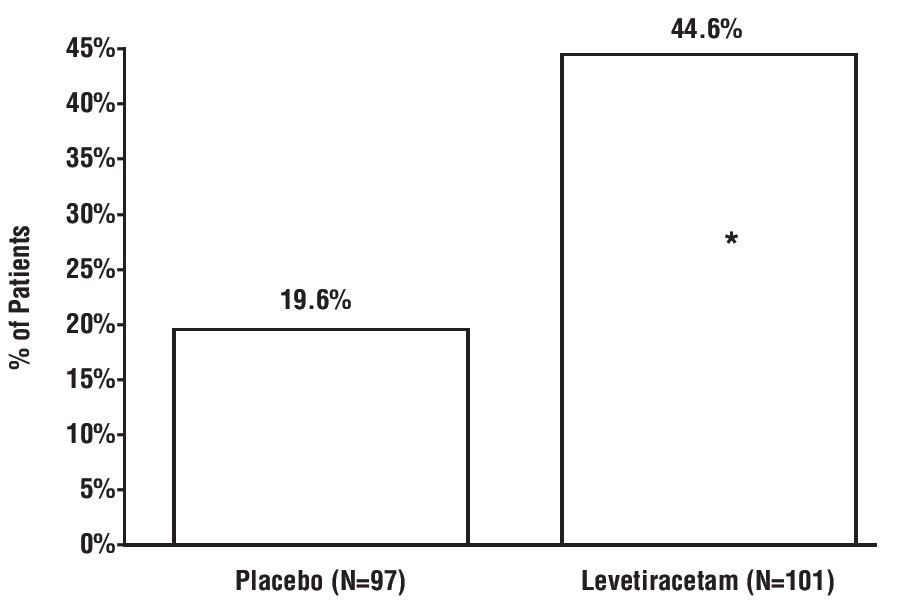
*statistically significant versus placebo
Effectiveness in Partial-Onset Seizures in Pediatric Patients 1 Month to <4
Years of Age
The effectiveness of levetiracetam for the treatment of partial-onset seizures
in pediatric patients was established in one multicenter, randomized double-
blind, placebo-controlled study (Study 5), conducted at 62 sites in North
America, South America, and Europe in pediatric patients 1 month to less than
4 years of age with partial seizures, uncontrolled by standard epileptic drugs
(AEDs). Eligible patients on a stable dose of 1 to 2 AEDs, who experienced at
least 2 partial-onset seizures during the 48-hour baseline video EEG were
randomized to receive either levetiracetam or placebo. The enrolled population
included 116 patients (levetiracetam N=60, placebo N=56) with refractory
partial-onset seizures, whether or not secondarily generalized. Randomization
was stratified by age range as follows: 1 month to less than 6 months of age
(N=4 treated with levetiracetam), 6 months to less than 1 year of age (N=8
treated with levetiracetam), 1 year to less than 2 years of age (N=20 treated
with levetiracetam), and 2 years to less than 4 years of age (N=28 treated
with levetiracetam). The study consisted of a 5-day evaluation period which
included a 1-day titration period followed by a 4-day maintenance period.
Levetiracetam dosing was determined by age and weight as follows: children 1
month to less than 6 months old were randomized to a target dose of 40
mg/kg/day, and children 6 months to less than 4 years old were randomized to a
target dose of 50 mg/kg/day. The primary measure of effectiveness was the
responder rate (percent of patients with ≥ 50% reduction from baseline in
average daily partial-onset seizure frequency) assessed by a blinded central
reader using a 48-hour video EEG performed during the last two days of the
4-day maintenance period. A total of 109 patients were included in the
efficacy analysis. A statistically significant difference between
levetiracetam and placebo was observed (see Figure 5). The treatment effect
associated with levetiracetam was consistent across age groups.
Figure 5: Responder Rate for All Patients Ages 1 Month to < 4 Years (≥ 50%
Reduction from Baseline) in Study 5
****
*****statistically significant versus placebo
14.2 Myoclonic Seizures in Patients with Juvenile Myoclonic Epilepsy
The effectiveness of levetiracetam as adjunctive therapy in patients 12 years of age and older with juvenile myoclonic epilepsy (JME) experiencing myoclonic seizures was established in one multicenter, randomized, double-blind, placebo-controlled study (Study 6), conducted at 37 sites in 14 countries. Eligible patients on a stable dose of 1 antiepileptic drug (AED) experiencing one or more myoclonic seizures per day for at least 8 days during the prospective 8-week baseline period were randomized to either levetiracetam or placebo (levetiracetam N=60, placebo N=60). Patients were titrated over 4 weeks to a target dose of 3000 mg/day and treated at a stable dose of 3000 mg/day over 12 weeks (evaluation period). Study drug was given in 2 divided doses.
The primary measure of effectiveness was the proportion of patients with at least 50% reduction in the number of days per week with one or more myoclonic seizures during the treatment period (titration + evaluation periods) as compared to baseline. Of the 120 patients enrolled, 113 had a diagnosis of confirmed or suspected JME. Table 14 displays the results for the 113 patients with JME in this study.
Table 14: Responder Rate (≥50% Reduction from Baseline) in Myoclonic Seizure Days per Week for Patients with JME in Study 6
|
Placebo |
Levetiracetam (N=54) | |
|
Percentage of responders |
23.7% |
60.4%* |
*statistically significant versus placebo
14.3 Primary Generalized Tonic-Clonic Seizures
The effectiveness of levetiracetam as adjunctive therapy in patients 6 years
of age and older with idiopathic generalized epilepsy experiencing primary
generalized tonic-clonic (PGTC) seizures was established in one multicenter,
randomized, double-blind, placebo-controlled study (Study 7), conducted at 50
sites in 8 countries. Eligible patients on a stable dose of 1 or 2
antiepileptic drugs (AEDs) experiencing at least 3 PGTC seizures during the
8-week combined baseline period (at least one PGTC seizure during the 4 weeks
prior to the prospective baseline period and at least one PGTC seizure during
the 4-week prospective baseline period) were randomized to either
levetiracetam or placebo. The 8-week combined baseline period is referred to
as “baseline” in the remainder of this section. Patients were titrated over 4
weeks to a target dose of 3000 mg/day for adults or a pediatric target dose of
60 mg/kg/day and treated at a stable dose of 3000 mg/day (or 60 mg/kg/day for
children) over 20 weeks (evaluation period). Study drug was given in 2 equally
divided doses per day. The primary measure of effectiveness was the percent
reduction from baseline in weekly PGTC seizure frequency for levetiracetam and
placebo treatment groups over the treatment period (titration + evaluation
periods). The population included 164 patients (levetiracetam N=80, placebo
N=84) with idiopathic generalized epilepsy (predominately juvenile myoclonic
epilepsy, juvenile absence epilepsy, childhood absence epilepsy, or epilepsy
with Grand Mal seizures on awakening) experiencing primary generalized tonic-
clonic seizures. Each of these syndromes of idiopathic generalized epilepsy
was well represented in this patient population.
There was a statistically significant decrease from baseline in PGTC frequency
in the levetiracetam-treated patients compared to the placebo-treated
patients.
Table 15: Median Percent Reduction from Baseline in PGTC Seizure Frequency
per Week in Study 7
|
Placebo (N=84) |
Levetiracetam (N=78) | |
|
Percent reduction in PGTC seizure |
44.6% |
77.6%* |
*statistically significant versus placebo
The percentage of patients (y-axis) who achieved ≥50% reduction in weekly
seizure rates from baseline in PGTC seizure frequency over the entire
randomized treatment period (titration + evaluation period) within the two
treatment groups (x-axis) is presented in Figure 6.
Figure 6: Responder Rate (≥50% Reduction from Baseline) in PGTC Seizure
Frequency per Week in Study 7
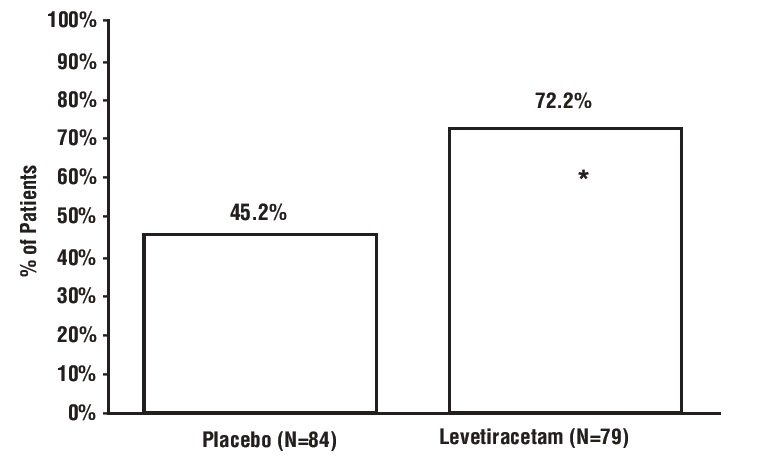
*statistically significant versus placebo
HOW SUPPLIED SECTION
16 HOW SUPPLIED/STORAGE AND HANDLING
16.1 How Supplied
Levetiracetam tablets USP, 250 mg are blue colored, oblong shaped, scored, film coated tablets debossed with ‘H’ on one side and ‘87’ on other side. They are supplied in containers of
120 tablets (NDC 16714-034-01)
500 tablets (NDC 16714-034-02)
Levetiracetam tablets USP, 500 mg are yellow colored, oblong shaped, scored, film coated tablets debossed with ‘H’ on one side and ‘88’ on other side. They are supplied in containers of
120 tablets (NDC 16714-035-01)
500 tablets (NDC 16714-035-02)
Levetiracetam tablets USP, 750 mg are orange colored, oblong shaped, scored, film coated tablets debossed with ‘H’ on one side and ‘90’ on other side. They are supplied in containers of
120 tablets (NDC 16714-537-01)
500 tablets (NDC 16714-537-02)
Levetiracetam tablets USP, 1000 mg are white colored, oblong shaped, scored, film coated tablets debossed with ‘H’ on one side and ‘91’ on other side. They are supplied in containers of
60 tablets (NDC 16714-310-01)
16.2 Storage
Store at 20° to 25°C (68° to 77°F) [see USP Controlled Room Temperature].
INFORMATION FOR PATIENTS SECTION
17 PATIENT COUNSELING INFORMATION
Advise the patient to read the FDA-approved patient labeling (Medication
Guide). The Medication Guide accompanies the product and can also be accessed
by calling 1-800-206-7821
Psychiatric Reactions and Changes in Behavior
Advise patients that levetiracetam may cause changes in behavior (e.g.
aggression, agitation, anger, anxiety, apathy, depression, hostility, and
irritability) and psychotic symptoms [see Warnings and Precautions ( 5.1)] .
Suicidal Behavior and Ideation
Counsel patients, their caregivers, and/or families that antiepileptic drugs
(AEDs), including levetiracetam, may increase the risk of suicidal thoughts
and behavior and advise patients to be alert for the emergence or worsening of
symptoms of depression; unusual changes in mood or behavior; or suicidal
thoughts, behavior, or thoughts about self-harm. Advise patients, their
caregivers, and/or families to immediately report behaviors of concern to a
healthcare provider [see Warnings and Precautions ( 5.2)] .
Effects on Driving or Operating Machinery
Inform patients that levetiracetam may cause dizziness and somnolence. Inform
patients not to drive or operate machinery until they have gained sufficient
experience on levetiracetam to gauge whether it adversely affects their
ability to drive or operate machinery [see Warnings and Precautions ( 5.3)] .
Anaphylaxis and Angioedema
Advise patients to discontinue levetiracetam and seek medical care if they
develop signs and symptoms of anaphylaxis or angioedema [see Warnings and Precautions ( 5.4)] .
Dermatological Adverse Reactions
Advise patients that serious dermatological adverse reactions have occurred in
patients treated with levetiracetam and instruct them to call their physician
immediately if a rash develops [see Warnings and Precautions ( 5.5)] .
Withdrawal of levetiracetam
Advise patients and caregivers not to discontinue use of levetiracetam without
consulting with their healthcare provider. Levetiracetam should normally be
gradually withdrawn to reduce the potential of increased seizure frequency and
status epilepticus [see Warnings and Precautions ( 5.7)] .
Pregnancy
Advise patients to notify their healthcare provider if they become pregnant or
intend to become pregnant during levetiracetam therapy. Encourage patients to
enroll in the North American Antiepileptic Drug (NAAED) pregnancy registry if
they become pregnant [see Use in Specific Populations ( 8.1)] .
Medication Guide available at www.northstarrxllc.com/productsor call 1-800-206-7821
Manufactured for:
Northstar Rx LLC
Memphis, TN 38141.
Manufactured by:
Hetero Labs Limited
Jeedimetla, Hyderabad - 500 055,
India.
Or
Manufactured by: Annora Pharma Pvt. Ltd.
Sangareddy - 502313, Telangana, India.
Revised: 11/2023
